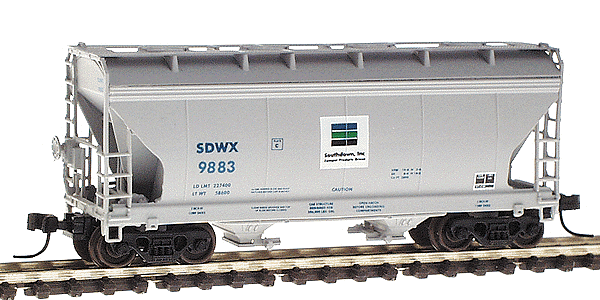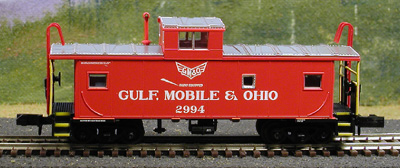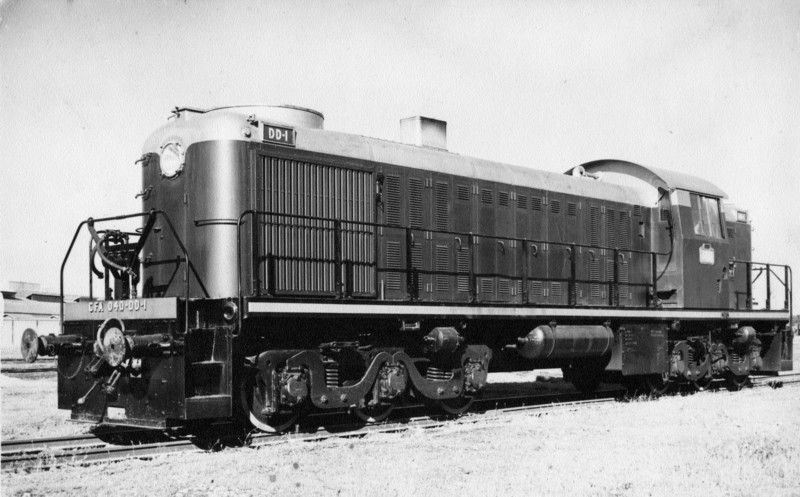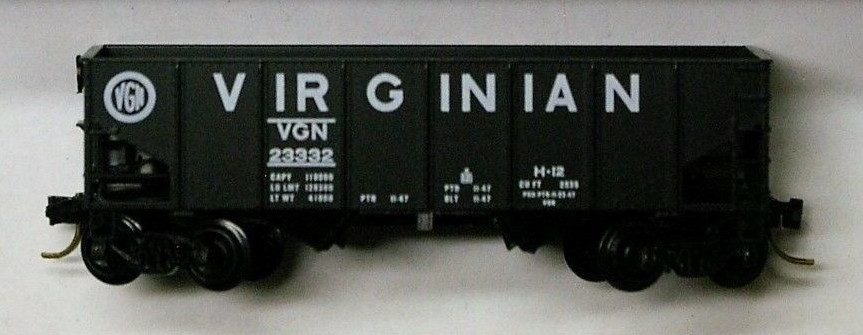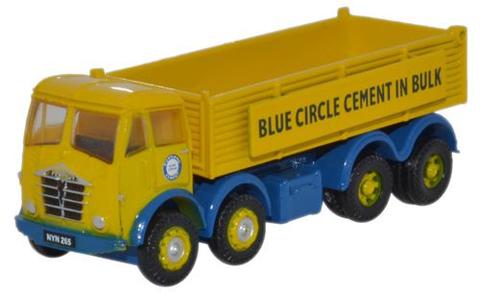Prototype History: The 2-bay covered hopper first entered service in the 1950s. The cars handle loads such as cement, sand and similar denser bulk commodities. In the 1960s, American Car and Foundry introduced the Centerflow design. The Centerflow relies on the car's rounded body to provide structural strength without the added weight of bracing, as well as making gravity unloading easier. This 2-bay car came in a 2,970-cubic foot capacity.
The first ACF covered hoppers were rib-side cars, like many others of the time. In the 1960's ACF eliminated the supporting ribs and started building what they called the Center Flow(R) hopper with a smooth, rounded side. The cars were built at several ACF plants, but the Huntington, West Virginia plant built only Center Flow cars since their inception and was the primary builder.
The first ACF covered hoppers were rib-side cars, like many others of the time. In the 1960's ACF eliminated the supporting ribs and started building what they called the Center Flow(R) hopper with a smooth, rounded side. The cars were built at several ACF plants, but the Huntington, West Virginia plant built only Center Flow cars since their inception and was the primary builder.
Road Name History: 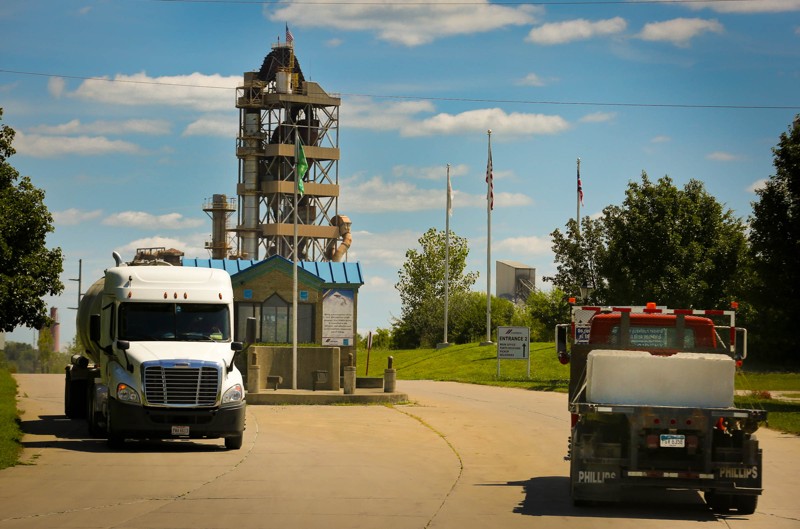 Southdown was a cement making company that was acquired in 2000 by Cemex. Southdown was based in Houston, TX. The acquisition at $2.6 billion represented the biggest-ever (at the time) acquisition by a Mexican company that would capture a prize U.S. asset in an industry that is consolidating globally.
Southdown was a cement making company that was acquired in 2000 by Cemex. Southdown was based in Houston, TX. The acquisition at $2.6 billion represented the biggest-ever (at the time) acquisition by a Mexican company that would capture a prize U.S. asset in an industry that is consolidating globally.
Southdown was one of the largest producers of cement and ready-mix concrete in the United States, Southdown, Inc. was also regarded as one of the industry's most efficient and modern producers. With eight manufacturing plants in California, Colorado, Florida, Kentucky, Ohio, Pennsylvania, Tennessee, and Texas, Southdown had distinguished itself as a leading competitor in an industry of vital importance to the construction industry, particularly large-scale public works projects. During the mid-1990s, more than half of the company's annual revenues and a substantially larger proportion of its operating earnings were generated from the production of cement, the primary binding agent in concrete. Southdown is also involved in the production of ready-mixed concrete, a building material used in myriad construction activities and the end-product of roughly 70 percent of the cement used in the United States. By gradually narrowing its focus on the production and marketing of these two products from the mid-1970s forward, Southdown established a solid position for itself in crucial cement and concrete markets across the country, particularly in Florida and southern California.
Southdown was founded as Realty Operators, Inc. in the spring of 1930, beginning its corporate life in Louisiana as a sugar cane grower during the incipient stages of the United States' greatest economic calamity. The company survived the decade-long ravages of the Great Depression, spending its formative years in the crucible of economic turmoil, then rallied forward through the United States' greatest military effort, withstanding the disruptive yet economically vibrant years of the Second World War. In 1948, three years after the conclusion of the war, Realty Operators changed its name to Southdown Sugars, Inc., borrowing the Southdown name from the Southdown sugar cane plantation in Houma, Louisiana. Over the course of the next 20 years, Southdown Sugars increased its stature as a sugar cane company, benefitting from the most advantageous economic conditions since its formation. The company changed its name again in 1959 to Southdown, Inc., prophetically dropping "Sugars" from its corporate title as it prepared to enter the 1960s, the last decade the company would rely exclusively on sugar cane cultivation and production to drive its growth.

Southdown was one of the largest producers of cement and ready-mix concrete in the United States, Southdown, Inc. was also regarded as one of the industry's most efficient and modern producers. With eight manufacturing plants in California, Colorado, Florida, Kentucky, Ohio, Pennsylvania, Tennessee, and Texas, Southdown had distinguished itself as a leading competitor in an industry of vital importance to the construction industry, particularly large-scale public works projects. During the mid-1990s, more than half of the company's annual revenues and a substantially larger proportion of its operating earnings were generated from the production of cement, the primary binding agent in concrete. Southdown is also involved in the production of ready-mixed concrete, a building material used in myriad construction activities and the end-product of roughly 70 percent of the cement used in the United States. By gradually narrowing its focus on the production and marketing of these two products from the mid-1970s forward, Southdown established a solid position for itself in crucial cement and concrete markets across the country, particularly in Florida and southern California.
Southdown was founded as Realty Operators, Inc. in the spring of 1930, beginning its corporate life in Louisiana as a sugar cane grower during the incipient stages of the United States' greatest economic calamity. The company survived the decade-long ravages of the Great Depression, spending its formative years in the crucible of economic turmoil, then rallied forward through the United States' greatest military effort, withstanding the disruptive yet economically vibrant years of the Second World War. In 1948, three years after the conclusion of the war, Realty Operators changed its name to Southdown Sugars, Inc., borrowing the Southdown name from the Southdown sugar cane plantation in Houma, Louisiana. Over the course of the next 20 years, Southdown Sugars increased its stature as a sugar cane company, benefitting from the most advantageous economic conditions since its formation. The company changed its name again in 1959 to Southdown, Inc., prophetically dropping "Sugars" from its corporate title as it prepared to enter the 1960s, the last decade the company would rely exclusively on sugar cane cultivation and production to drive its growth.
Brand/Importer Information: InterMountain was founded in 1985 by Fred Brummet. They got started in the model railroad business by producing O-Scale model kits. They got started in the N Scale business almost a decade later when in 1994 they introduced the 40-23 reefer car in kit form. Later, in 1998, they started producing RTR (Ready-to-Run) models. By the early 2000s, InterMountain phased out kit production in favor of the RTR models.
The InterMountain Railway company is located at 1224 Boston Ave in Longmont, CO. They are a manufacturer of HO, N and Z scale model trains. They have produced kits as well as RTR (Ready-To-Run) models. Their N Scale products include locomotives as well as rolling stock. Their rolling stock lineup includes Boxcars, Hoppers, Tank Cars, Reefers, Gondolas, Stock Cars and Flatcars.
Their locomotive releases have primarily been diesel units, with the one major exception being their series of AC-12 Cab Forward steam locos. Their diesel lineup includes F3's, F7's, F9's, SD40's, SD45's and FT units. They are known for quality and detail. They also release their rolling stock in larger varieties of road numbers than most of the other manufacturers.
The InterMountain Railway company is located at 1224 Boston Ave in Longmont, CO. They are a manufacturer of HO, N and Z scale model trains. They have produced kits as well as RTR (Ready-To-Run) models. Their N Scale products include locomotives as well as rolling stock. Their rolling stock lineup includes Boxcars, Hoppers, Tank Cars, Reefers, Gondolas, Stock Cars and Flatcars.
Their locomotive releases have primarily been diesel units, with the one major exception being their series of AC-12 Cab Forward steam locos. Their diesel lineup includes F3's, F7's, F9's, SD40's, SD45's and FT units. They are known for quality and detail. They also release their rolling stock in larger varieties of road numbers than most of the other manufacturers.
Item created by: CMK on 2019-09-01 12:01:20. Last edited by gdm on 2020-06-02 13:42:22
If you see errors or missing data in this entry, please feel free to log in and edit it. Anyone with a Gmail account can log in instantly.
If you see errors or missing data in this entry, please feel free to log in and edit it. Anyone with a Gmail account can log in instantly.


